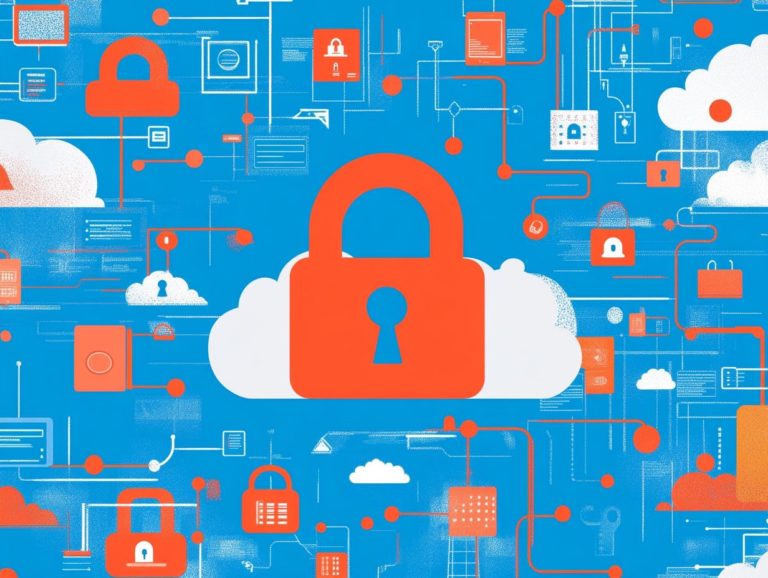7 Essential Cloud Security Tools for 2024
Don’t wait until it’s too late! Securing your cloud is essential now more than ever. In today’s digital landscape, securing your cloud environments has never been more crucial. As you increasingly rely on cloud services, grasping the essential security tools becomes vital for your success.
This article covers seven tools to boost your cloud security, ranging from encryption and access management to intrusion detection and data loss prevention.
You ll discover the evolution of cloud security, the primary threats organizations face, and best practices for effectively implementing these tools.
Whether you’re a seasoned IT professional or a business owner, this guide is tailored to help you navigate the complexities of cloud security in 2024.
Contents
- Key Takeaways:
- 1. Encryption Tools
- 2. Access Management Tools
- 3. Intrusion Detection and Prevention Systems
- 4. Network Security Tools
- 5. Data Loss Prevention Tools
- 6. Backup and Disaster Recovery Tools
- 7. Vulnerability Scanning Tools
- What Is Cloud Security and Why Is It Important?
- How Has Cloud Security Evolved in Recent Years?
- What Are the Main Threats to Cloud Security?
- How Can These Tools Help Mitigate Cloud Security Risks?
- What Are the Key Features to Look for in a Cloud Security Tool?
- How Can a Business Choose the Right Cloud Security Tools for Their Needs?
- What Are the Best Practices for Implementing and Maintaining Cloud Security?
- Frequently Asked Questions
- 1. What are the 7 essential cloud security tools for 2024?
- 2. Why are these cloud security tools considered essential for 2024?
- 3. What is a cloud access security broker (CASB)?
- 4. How does data loss prevention (DLP) help protect against data breaches?
- 5. What is the importance of identity and access management (IAM) tools in cloud security?
- 6. How do vulnerability scanners contribute to cloud security?
Key Takeaways:

Encryption tools are essential for protecting sensitive data in the cloud, providing an extra layer of security against potential cyber threats.
Access management tools help businesses control and monitor user access to cloud resources, reducing the risk of unauthorized access and data breaches.
Intrusion detection and prevention systems are crucial in identifying and stopping potential attacks on cloud systems before they can cause any harm.
1. Encryption Tools
Encryption tools are essential elements of your cloud security strategy, providing methods to protect sensitive data both transmitted and stored within cloud environments. These tools are your first line of defense against unauthorized access and potential security breaches.
Utilizing various encryption protocols, including AES and RSA, ensures that your data is encrypted both at rest and in transit, granting access only to authorized users.
Using advanced encryption helps you meet important regulations like GDPR and HIPAA, which demand robust data protection measures to safeguard personal information.
Integrating these encryption tools into your broader security strategies such as multi-factor authentication and intrusion detection systems enhances the overall security posture of your cloud services. This creates a comprehensive defense mechanism that addresses vulnerabilities and fosters trust with clients and partners.
2. Access Management Tools
Access management tools are essential to your cloud security strategy, giving you the power to oversee user identities and control access to sensitive information and applications within your cloud environment.
These tools include a range of identity and access management tools that are vital for enforcing strict access control policies. IAM tools help you control who can access your cloud resources, ensuring that only authorized personnel gain access to critical assets.
They also provide comprehensive tracking and auditing capabilities, enabling you to monitor user activities and identify potential vulnerabilities before they escalate into serious security incidents.
In today’s landscape of mounting cyber threats, enhancing your security posture with robust IAM solutions not only helps prevent breaches but also cultivates a culture of security awareness among your employees.
3. Intrusion Detection and Prevention Systems
Intrusion Detection and Prevention Systems (IDPS) are essential security tools that monitor your network traffic for any suspicious activities, enabling you to detect threats promptly and respond effectively to potential cyber risks.
By continuously analyzing both incoming and outgoing data, these systems can pinpoint vulnerabilities and recognize patterns that may signal impending attacks. They provide a multi-layered defense mechanism that alerts you to abnormalities and proactively blocks potential intrusions.
Within your broader security framework, IDPS seamlessly integrates with other solutions like firewalls and endpoint protection, significantly enhancing the resilience of your cloud security infrastructure. Their capacity to adapt and learn from evolving threats ensures that you remain vigilant in an ever-changing cyber landscape, ultimately bolstering your organization s security posture.
Ready to strengthen your cloud security? Explore these tools today!
4. Network Security Tools
Network security tools are essential for safeguarding your cloud infrastructure. They protect data transmitted across networks with features designed to stop unauthorized access and data breaches.
By implementing a variety of technologies, you can use firewalls as barriers between trusted internal networks and untrusted external ones. These firewalls carefully check incoming and outgoing traffic.
Virtual Private Networks (VPNs) further enhance your security by encrypting connections. This encryption keeps your data safe while it travels over public networks.
Together, these tools are crucial for a strong security strategy. They protect sensitive information and help you comply with industry standards like GDPR (General Data Protection Regulation) and HIPAA (Health Insurance Portability and Accountability Act).
They address risk factors and streamline your monitoring processes. This makes security management more efficient and effective.
5. Data Loss Prevention Tools

Data Loss Prevention (DLP) tools are crucial for protecting sensitive information in cloud environments. They aim to stop unauthorized access and ensure regulatory compliance.
These tools monitor your data in transit and at rest. They use advanced analytics to identify unusual patterns that might indicate a security threat.
If a potential data breach occurs, DLP solutions can act quickly. They may block or encrypt sensitive data to reduce risks in real time.
DLP tools are valuable during security audits. They provide insights and reports needed to show compliance with standards like PCI DSS and GDPR.
By regularly evaluating your data handling practices, DLP tools help safeguard information and build trust with customers and stakeholders.
6. Backup and Disaster Recovery Tools
Backup and disaster recovery tools are vital for protecting your data in cloud environments. They empower you to recover lost information and keep operations running smoothly during unexpected incidents.
With data breaches and system failures becoming common, robust backup and disaster recovery strategies are essential. Now is the time to adopt these solutions!
Many cloud storage options offer automated backup features. This allows you to save copies of your data without needing constant manual work.
Implementing multi-region backups further shields your data from localized outages. These measures enhance business resilience and security.
Leveraging these solutions not only strengthens your security but also ensures your organization can quickly resume operations, reducing the impact of security incidents.
A proactive approach fosters trust with clients and stakeholders. This reinforces your reputation in an unpredictable environment.
7. Vulnerability Scanning Tools
Vulnerability scanning tools are key assets in your cloud security strategy. They help identify security gaps and weaknesses in your applications and cloud workloads through continuous monitoring.
These tools systematically check your systems for known vulnerabilities. They analyze configurations and assess compliance with security standards.
Incorporating automated scans into your risk assessment process allows you to prioritize remediation based on the severity of vulnerabilities. This makes patch management easier and provides insights into your overall security framework.
Consequently, using these tools consistently creates a culture of improvement, empowering your organization to stay ahead of evolving cyber threats.
What Is Cloud Security and Why Is It Important?
Cloud security includes various strategies, technologies, and practices tailored to protect your cloud environments from cyber threats. It ensures compliance with regulatory requirements while safeguarding sensitive data and maintaining strong security management practices.
A solid cloud security approach is essential for any business using cloud services. You need to implement effective threat detection systems that can spot anomalies and potential breaches in real-time. This is crucial for minimizing data loss or damage.
Employing strong data protection methods, such as encryption and access controls, further fortifies your cloud against unauthorized access. By adhering to compliance requirements, you not only avoid legal pitfalls but also build trust with your customers, demonstrating your commitment to maintaining data integrity and confidentiality.
In today s rapidly evolving digital landscape, prioritizing cloud security is crucial for keeping your business running smoothly and safely.
How Has Cloud Security Evolved in Recent Years?
In recent years, cloud security has undergone a remarkable transformation, evolving to meet emerging threats and the intricate demands of solutions designed specifically for cloud environments.
As you navigate the increasing migration to the cloud, you will encounter a rapidly shifting landscape of cybersecurity challenges. Innovations like artificial intelligence and machine learning are becoming integral to security measures, significantly enhancing your threat detection capabilities.
The growth of multi-cloud environments forces businesses to adopt stronger security strategies for safeguarding data across various platforms.
These adjustments highlight a broader trend toward proactive security postures, empowering you to not only respond to potential threats but also to anticipate and mitigate risks before they escalate.
What Are the Main Threats to Cloud Security?

The primary threats to your cloud security encompass a range of cyber risks, including security breaches, malware attacks, and insider threats. Each of these can exploit vulnerabilities within your cloud infrastructure, potentially leading to significant security incidents.
Recent high-profile incidents have brought these dangers into sharp focus. For instance, the notorious breach of a major cloud service provider exposed sensitive data and impacted countless organizations. Similarly, ransomware attacks have increasingly targeted cloud storage systems, demanding substantial ransoms for restoring access.
The ramifications of such threats are serious, resulting in everything from financial losses to irreparable reputational damage. To mitigate these risks, you are advised to adopt several key strategies:
- Implement a method that requires more than one form of verification.
- Conduct regular security audits.
- Establish comprehensive employee training programs.
By integrating these proactive measures, you can significantly strengthen your defenses, making it considerably more difficult for cybercriminals to compromise your cloud environments.
How Can These Tools Help Mitigate Cloud Security Risks?
The integration of diverse security tools is essential for you in mitigating cloud security risks. These tools facilitate comprehensive risk assessments, robust incident response, and ensure adherence to compliance requirements across your cloud environments.
Each tool serves a specific purpose, such as automated vulnerability scanning and continuous monitoring, empowering you to identify potential weaknesses before they can be exploited.
Advanced threat detection systems leverage machine learning algorithms to analyze patterns and pinpoint suspicious activities, enabling you to intervene promptly. Incident response tools allow your team to craft and implement response strategies, effectively minimizing the impact of security breaches.
Compliance-focused solutions help ensure you meet stringent industry standards, instilling confidence in your stakeholders and safeguarding sensitive data, all while cultivating a proactive security posture.
What Are the Key Features to Look for in a Cloud Security Tool?
When selecting cloud security tools, you should prioritize key features such as automated tools for continuous security monitoring, effective data protection capabilities, and steadfast adherence to compliance standards.
It’s essential to recognize the importance of real-time monitoring, which allows you to identify and respond to potential threats immediately.
Another crucial aspect is adaptability to multi-cloud environments, enabling you to ensure seamless protection across various cloud platforms.
Strong integration with your existing security frameworks can streamline processes, making it easier for your team to manage defenses without the need to overhaul current systems.
These features work together to create a robust security posture, empowering you to safeguard your data and maintain regulatory compliance more effectively than ever.
How Can a Business Choose the Right Cloud Security Tools for Their Needs?
Choosing the right cloud security tools for your business requires a careful risk assessment. You need to consider specific security practices, compliance requirements, and the tailored solutions necessary to safeguard your sensitive data effectively.
Start by evaluating your organization s unique business needs; this will help you pinpoint the critical areas that demand protection. Next, conduct a comprehensive assessment that analyzes your existing security frameworks and identifies potential vulnerabilities.
Incorporating feedback from security training sessions is crucial; this will shed light on areas that need improvement, ensuring that the tools you select resonate with your team s understanding and practices.
It s vital to ensure these tools integrate seamlessly with your broader security strategies and compliance regulations, creating a cohesive security posture that adapts to emerging threats and supports the growth of your business.
What Are the Best Practices for Implementing and Maintaining Cloud Security?
To implement and maintain effective cloud security, you need to commit to best practices. This includes conducting regular security audits, developing proactive incident response plans, and nurturing a culture of security awareness among your employees.
To protect sensitive data and assets, prioritize continuous monitoring of your security protocols. This ensures that any vulnerabilities are identified and addressed in real-time.
A robust training program is essential, equipping your staff with the skills needed to recognize potential threats and respond appropriately.
By adopting a holistic approach that encompasses every aspect of your organization s operations, you not only strengthen your cloud security measures but also create a resilient framework capable of adapting to evolving threats. This multifaceted strategy ultimately fosters a secure environment that encourages innovation and growth.
Frequently Asked Questions

1. What are the 7 essential cloud security tools for 2024?
The 7 essential cloud security tools for 2024 are: cloud access security brokers (CASB), data loss prevention (DLP) tools, network security tools, Identity and Access Management (IAM) tools, encryption tools, vulnerability scanners, and security information and event management (SIEM) tools.
2. Why are these cloud security tools considered essential for 2024?
These tools are considered essential for 2024 because cloud computing is expected to continue to grow and become the primary method of storing and accessing data. As more sensitive information is moved to the cloud, the growing importance of cloud security becomes critical to protect it.
3. What is a cloud access security broker (CASB)?
A cloud access security broker (CASB) is a tool that helps manage and protect your cloud data by acting as a mediator between your company’s internal network and the cloud. It helps to monitor and secure cloud usage, enforce security policies, and prevent unauthorized access to sensitive data.
4. How does data loss prevention (DLP) help protect against data breaches?
Data loss prevention (DLP) tools monitor and detect sensitive data as it is stored, accessed, or shared in the cloud. They enforce policies that prevent unauthorized access and data leakage, actively protecting against accidental or intentional exposure.
5. What is the importance of identity and access management (IAM) tools in cloud security?
Identity and access management (IAM) tools control and manage user access to cloud resources and data. These tools prevent unauthorized access and ensure only the right users can access sensitive information.
6. How do vulnerability scanners contribute to cloud security?
Vulnerability scanners scan cloud systems and applications for weaknesses that hackers can exploit. By identifying these vulnerabilities, we can patch them effectively and keep our systems secure.






